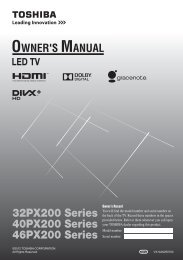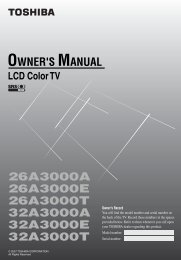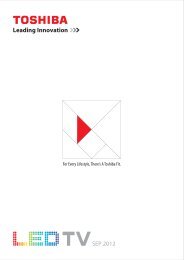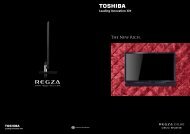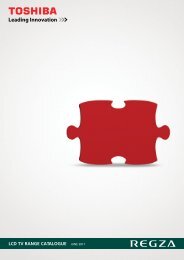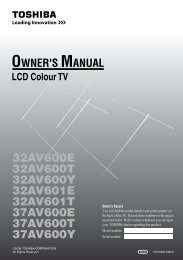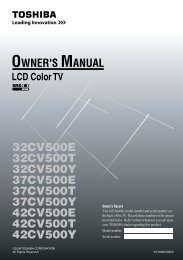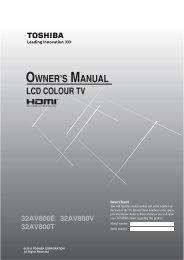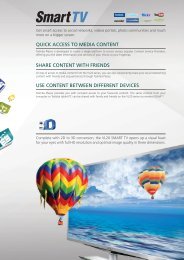37A3000A 37A3000E 37A3000T 42A3000A ... - Toshiba REGZA
37A3000A 37A3000E 37A3000T 42A3000A ... - Toshiba REGZA
37A3000A 37A3000E 37A3000T 42A3000A ... - Toshiba REGZA
Create successful ePaper yourself
Turn your PDF publications into a flip-book with our unique Google optimized e-Paper software.
Connecting an HDMI or a DVI device<br />
When turning on your electronic components, turn on the<br />
TV first, and then the HDMI or DVI device.<br />
When turning off your electronic components, turn off the<br />
HDMI or DVI device first, and then the TV.<br />
This TV may not be compatible with features and/or<br />
specifications that may be added in the future.<br />
This TV is only operable with L-PCM on 32/44.1/48 kHz<br />
and 16/20/24 bits. If there is no sound when using HDMI,<br />
use the analog audio cables to connect the TV and the HDMI<br />
device, and select Analog in HDMI audio of the AV<br />
connection menu (- page 24).<br />
This TV is able to connect with HDMI devices. But it is<br />
possible that some HDMI devices may not operate properly<br />
with this TV.<br />
Connecting an HDMI or a DVI device<br />
The HDMI input on your TV receives digital audio and<br />
uncompressed digital video from an HDMI device or<br />
uncompressed digital video from a DVI device.<br />
This input is designed to accept HDCP program material in<br />
digital from EIA/CEA-861/861B compliant consumer<br />
electronic devices (such as a set top box or DVD player with<br />
HDMI or DVI output).<br />
The HDMI input is designed for best performance with 1080i<br />
(50 Hz/60 Hz) high-definition video signals, but will also<br />
accept and display 480i, 480p, 576i, 576p, 720p (50 Hz/60 Hz<br />
(60Hz: except for the E-EDID)) and VGA signals.<br />
HDMI: High-Definition Multimedia Interface<br />
DVI: Digital Video Interface<br />
HDCP: High-bandwidth Digital Content Protection<br />
EIA/CEA-861/861B compliance covers the transmission of<br />
uncompressed digital video with high-bandwidth digital<br />
content protection, which is being standardized for<br />
reception of high-definition video signals. Because this is an<br />
evolving technology, it is possible that some devices may<br />
not operate properly with the TV.<br />
E-EDID: Enhanced-Extended Display Identification<br />
VGA: VESA 640 5 480 @ 60 Hz<br />
L-PCM: Linear-Pulse Code Modulation<br />
Connecting your TV<br />
Connecting an HDMI device<br />
One HDMI cable (type A connector)<br />
HDMI device<br />
For proper operation, it is recommended that you use a short<br />
HDMI cable.<br />
HDMI cable transfers both video and audio.<br />
Connecting a DVI device<br />
One HDMI (type A connector)-to-DVI adapter cable and<br />
audio cables<br />
TV back view<br />
DVI device<br />
VIDEO AUDIO<br />
L R<br />
IN<br />
VIDEO AUDIO<br />
L R<br />
IN<br />
TV back view<br />
OUT<br />
HDMI (type A connector)-to-DVI adapter cable<br />
For proper operation, the length of an HDMI-to-DVI adapter<br />
cable should not exceed 3m. The recommended length is 2m.<br />
Standard analog audio cables<br />
An HDMI-to-DVI adapter cable transfers only video.<br />
Separate analog audio cables are required.<br />
OUT<br />
HDMI OUT<br />
TV back view<br />
Note:<br />
HDMI, the HDMI logo, and High-Definition Multimedia<br />
Interface are trademarks or registered trademarks of HDMI<br />
Licensing, LLC.<br />
DVI<br />
OUT<br />
23




